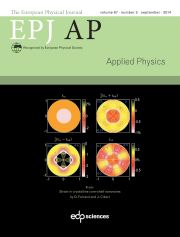Article contents
Unusual high sensitivity in highly oriented laser ablated thin films of SnO2 on (1102) sapphire and (100) LaAlO3
Published online by Cambridge University Press: 15 April 2002
Abstract
A systematic investigation on growth and sensor characteristics of SnO2 thin films
of different orientations is reported for the first time. Thin films were grown by pulsed
laser (KrF; λ = 248 nm) ablation technique under in-situ conditions. Films deposited at
525 °C on (1102) sapphire were predominantly (101) orientated whereas those deposited
on (100) LaAlO3 were highly a-axis orientated. Sensors made of predominantly (101)
oriented films exhibited more than two orders magnitude change in resistance even for
100 ppm of H2 in air at 310 °C. The response and retracing times of the sensor were
remarkably short respectively 30 and 200 s. Sensors made of a-axis oriented films also
exhibited similar sensitivity and response time for the same quantity of both H2 and LPG.
However, the retrace time was very long typically about 20 min. Atomic force
microscopic (AFM) investigation reveals that the films are highly granular with an
average size of about 100–150 nm which is ten times larger than the critical size of 6
nm, a criterion required for high sensitivity. (The Debye length of ${\rm SnO}_2 \cong
3.07$ nm at 293 K and the critical grain size is therefore 2 × Debye length, which
is 6 nm.)
nm at 293 K and the critical grain size is therefore 2 × Debye length, which
is 6 nm.)
- Type
- Research Article
- Information
- Copyright
- © EDP Sciences, 2002
References
- 1
- Cited by


